| Robot Sports |
|
||||||||||||||||||||
|
Stiquito Kit BattleKits Robot Toys Solar Kits Robot Arms Robosapien Basic Stamp Kits Lego MindStorms
Hobby Robots Robot Sports Electronics Mechanics Robot Minds Books for Kids Robots at Work Microcontrollers Advanced Books Used Books
Robot Motors Remote Controls Robot Parts Robot Tools Magazines Robot Videos Robot News RoboLinks Contact
|
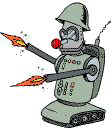 Since the BattleBots
robot combat competition became a weekly television show, we have been inundated with
emails from people who are interested in building a BattleBot. In response to the vast
public demand, we have put together this page of resources for the aspiring combat
robotics champion. We have had quite a bit of experience in this field since we sponsor
our own BattleBots robot. We also feature
books about robot soccer competitions on this page. Since the BattleBots
robot combat competition became a weekly television show, we have been inundated with
emails from people who are interested in building a BattleBot. In response to the vast
public demand, we have put together this page of resources for the aspiring combat
robotics champion. We have had quite a bit of experience in this field since we sponsor
our own BattleBots robot. We also feature
books about robot soccer competitions on this page.
|
||||||||||||||||||||
Technical editors Grant Imahara and Carlo Bertocchini are both BattleBots Champions. Read an excerpt from this book Chapter 1: Welcome to Competition Robotics
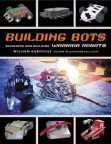 This is the definitive guide to designing and building warrior
robots like those seen on BattleBots, Robotica, and Robot Wars. It walks robot enthusiasts
of all ages step-by-step through the design and building process, enabling them to create
any number of customized warrior robots. With a strong emphasis on safety, chapters
include designing a robot, choosing materials, radio control systems, electric motors,
robot batteries, motor speed controllers, gasoline engines, and drive trains. Clear
instructions are accompanied by photos, line drawings, and detailed diagrams throughout. A
color section showcases a variety of glorious fighting machines. This is the definitive guide to designing and building warrior
robots like those seen on BattleBots, Robotica, and Robot Wars. It walks robot enthusiasts
of all ages step-by-step through the design and building process, enabling them to create
any number of customized warrior robots. With a strong emphasis on safety, chapters
include designing a robot, choosing materials, radio control systems, electric motors,
robot batteries, motor speed controllers, gasoline engines, and drive trains. Clear
instructions are accompanied by photos, line drawings, and detailed diagrams throughout. A
color section showcases a variety of glorious fighting machines.
For beginners, there is machine shop 101, basic robot physics, and chapters on weaponry that include spinner robots, thwackbots, cutting blade robots, lifters, and chameleon robots.
This book gives you an inside view of the world of robot combat. Browse through photo-filled profiles of every major BattleBot and get details on weight, speed, weapon type, and what it took to build them. Read about the different weapon types - including RamBots, SpinBots, ThwackBots, and Wedges. Meet the people behind the crowd-pleasing, spark-flying robot demolition and get step-by-step instructions for building your own fierce fighting machine. This big beautiful book will make a welcome addition to your robot library and your coffee table! Table of Contents:
Teams are given design specifications and a basic kit of parts and components, and then they select strategies to play the game, develop functional requirements, conceptualize a robot, source and fabricate parts and assemblies, test materials, and develop control code. The 45-day design cycle is a learning process and is delightfully revealed, without repetition, through the thirty profiles of award-winning robots and their developers. Robots were judged based on their performance in the many rounds of the game and the entries' creativity, design excellence, quality, and control system automation. This competition has been highlighted by major news organizations like NBC, CNN, Business Week online, and more, making this a high-profile, much anticipated yearly event among competitors and robot enthusiasts. The book will be a must-have item for those attending and participating in the events and gear heads, tinkerers, and electromechanical developers of all ages.
FIRST Lego League (FLL) is an international program for kids
ages 9 to 14 that combines a hands-on, interactive robotics program and
research presentation with a sports-like atmosphere. Authors James Floyd
Kelly and Jonathan Daudelin-both participants in numerous FIRST Lego League
competitions-have teamed up to bring coaches, teachers, parents, and
students an all-in-one guide to FLL.
With one or more pictures or diagrams on almost every page, Robot Sumo illustrates and explains in a clear and easy-to-understand way the various technologies, techniques, and tricks involved in building Sumo robots. Even if Sumo Robots are not your bag, you can use these same techniques to build other types of robots. Until now, if you wanted to get involved, you had to learn by trial and error or by watching and losing. Now, there's a shortcut -- Robot Sumo: The Official Guide
There were, at the time, high-minded, mildly competitive engineering challenges at MIT and elsewhere. But robots designed to destroy each other was different. The idea of battling 'bots' was eagerly adopted by clever nerds, garage mechanics, and jazzed gearheads, and in 1994, San Francisco was invaded by these awesome beasts in the first-ever robot combat event. The machines sported flippers and flame-throwers, probes, saws, spikes, and chainsaws as well as pistons, gears, treads, tires, and elaborate electronic circuitry. Sparks, smoke, and especially deafening noise characterized the affair. Television spotted the possibilities of the destructive machinery, and now on TV former Baywatch babes present the "Big Nut" trophies to the champions. It was more than a hobby. The commotion was called a sport, perhaps even art. In Gearheads, Newsweek's technology correspondent Brad Stone examines the history of robotic sports, from their cultish early years at universities and sci-fi conventions to today's televised extravaganzas -- and the turmoil that threatened the whole enterprise almost from the beginning. Casual fans of BattleBots will be shocked at the Machiavellian intrigue behind the scenes of the radio-controlled robotic warfare. Stone's original and surprisingly engaging account of the rise of robotic sports depicts a world hardly anyone not passionate about these gladiatorial gear fests would have ever suspected. All the elements of a taut thriller are here: paranoid geeks, rabid lawyers, sleazy executives, killer machines, and threats of physical violence. He documents how the American judicial system can be used as a personal Mafia-style hit squad to bludgeon a business partner into bankruptcy and physical ruin. Even Jay Leno and the guy who destroyed Run-DMC's career put in key appearances. Stone manages to find the universal elements in a story that people not familiar with robot sports can appreciate, and he lets those elements do the heavy lifting. His admonitory tale is strong on descriptions of the machines and the combat, but of even more interest are the people he candidly describes and their conniving and betrayal. The story moves fast and offers high-rpm clashes: A lawsuit-slinging exec reduces Thorpe to financial ruin, and supergeek Dean Kamen weighs in with dismay as cash and TV deals go to Segway's crude cousins. Stone chronicles the stories of the young enthusiast who had to be placed in a psych ward and the Bruce Wayne-like rich guy who tries to save the day. He profiles a well-known builder whose shifts of allegiance baffle his peers, to those who have elevated these robots from mere machines to works of art. Gearheads is a unique opportunity to watch a sport in its nascent stages develop rapidly from slightly obsessive leisure pursuit to corporate entertainment industry, complete with television shows and several lines of toys. It is the story of every underground phenomenon that struggles to remain true to its original vision, and every visionary artist who gets lost in an unforgiving system that favors capital over creativity.
The Sponsorship Seeker's Toolkit and accompanying disk provide a step-by-step, no-nonsense approach to securing, retaining, and managing sponsorships. The Toolkit is full of easy-to-use tools, techniques, resources, and templates, creating a straightforward framework for people just starting out in sponsorship, and enhancing the skills of seasoned professionals.
RoboCup- 2009 documents the achievements presented at the Robot World Cup Soccer Competition and Conference. The RoboCup teams consist of five robots. The winning teams use excellent mechanical design and advanced vision systems to get the edge. The book is packed with illustrations, and every page has a wealth of information. At 460 pages, the amount of knowledge packed into this book is incredible. RoboCup- 2009 opens with an overview presenting the history of this sport, the overall perspectives and challenges, and a survey of the state of the art. The technical paper section presents the latest research and development. The revised full papers and revised short papers presented together with award winning papers went through two rounds of reviewing and post-symposium improvements and were selected from over 100 paper submissions. The teams describe their robots in detail--everything from programming strategies to mechanical design. Also included is a league report summarizing the results of the various leagues running competitions. These books are mandatory reading for the rapidly growing RoboCup community as well as a valuable source of reference and inspiration for hobbyists and professionals interested in multi-agent systems, distributed artificial intelligence, robot vision, and intelligent robotics.
  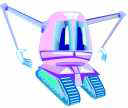 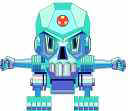
 |
|||||||||||||||||||||
|
Advertise your product on RobotBooks.com Beginners Books |
Hobby Robots |
Robot Sports |
Electronics |
Mechanics |
Robot Minds |
Robot Fiction |
|||||||||||||||||||||
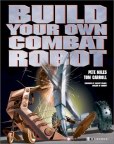 Experience
the excitement of building your own champion battling bot! Build a powerful
robot for full-blown competition with the help of this authoritative robot
resource. This team of experts gives you an inside look at the innovative
new world of robotic combat, explaining the origins of the sport as well as
all the elements that go into constructing a fighting robot. You'll learn
technical basics from motors and wiring to locomotion, and read builders'
true stories from the front lines of robot competition. Whether or not
you're mechanically minded, you'll find this book both entertaining and
informative. Fully capturing the spirit of the sport, this detailed guide
shows you how an imagination and a few bits of metal can start you on your
way to constructing your own champion bot.
Experience
the excitement of building your own champion battling bot! Build a powerful
robot for full-blown competition with the help of this authoritative robot
resource. This team of experts gives you an inside look at the innovative
new world of robotic combat, explaining the origins of the sport as well as
all the elements that go into constructing a fighting robot. You'll learn
technical basics from motors and wiring to locomotion, and read builders'
true stories from the front lines of robot competition. Whether or not
you're mechanically minded, you'll find this book both entertaining and
informative. Fully capturing the spirit of the sport, this detailed guide
shows you how an imagination and a few bits of metal can start you on your
way to constructing your own champion bot.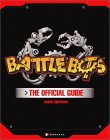 View
the metal-crunching destruction from the front lines with this behind the scenes guide to
BattleBots - one of today's hottest sporting events and a hit TV show! "BattleBots :
The Official Guide" is packed with full-color / full-page photographs, battle
statistics, and builder profiles and interviews.
View
the metal-crunching destruction from the front lines with this behind the scenes guide to
BattleBots - one of today's hottest sporting events and a hit TV show! "BattleBots :
The Official Guide" is packed with full-color / full-page photographs, battle
statistics, and builder profiles and interviews.  The FIRST Robotics competition partners school students
with engineering and design mentors to explore science, technology, and
themselves through robotics. The challenge for each team is to develop a
robot capable of out-performing oth0071408525 in a game that changes
annually. The authors document through photographs, drawings, and
text the 2007 FIRST competition: Rack 'n' Roll.
The FIRST Robotics competition partners school students
with engineering and design mentors to explore science, technology, and
themselves through robotics. The challenge for each team is to develop a
robot capable of out-performing oth0071408525 in a game that changes
annually. The authors document through photographs, drawings, and
text the 2007 FIRST competition: Rack 'n' Roll.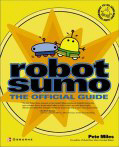 Robot
Sumo contests are now being held worldwide, with several thousand robots
busily trying to push each other out of the ring with ever-greater aplomb.
Now you can plan, design, and build your own powerful and innovative Sumo or
Mini-Sumo robot using this one-of-a-kind resource. Featuring complete
coverage of the rules and regulations of this increasingly popular
competitive sport, this authoritative guide will show you what it takes to
build a Sumo robot from beginning to end. Packed with helpful diagrams,
schematics, sample programs, and action photos of robots from around the
world, this book explains where to get the best parts and components for
your bot, building specifications for the Dohyo (the Sumo ring), gearing and
traction methods, motors, batteries, speed controllers, high quality
sensors, microcontrollers, programming strategies for robotic combat, and
tips on getting the most pushing power from your robot.
Robot
Sumo contests are now being held worldwide, with several thousand robots
busily trying to push each other out of the ring with ever-greater aplomb.
Now you can plan, design, and build your own powerful and innovative Sumo or
Mini-Sumo robot using this one-of-a-kind resource. Featuring complete
coverage of the rules and regulations of this increasingly popular
competitive sport, this authoritative guide will show you what it takes to
build a Sumo robot from beginning to end. Packed with helpful diagrams,
schematics, sample programs, and action photos of robots from around the
world, this book explains where to get the best parts and components for
your bot, building specifications for the Dohyo (the Sumo ring), gearing and
traction methods, motors, batteries, speed controllers, high quality
sensors, microcontrollers, programming strategies for robotic combat, and
tips on getting the most pushing power from your robot.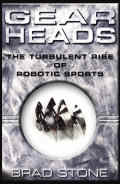 In the early nineties, a visionary special-effects guru named Marc Thorpe
conjured a field of dreams different from any the world had seen before: populated not by
ghostly ballplayers but by remote-controlled robots, armed to the steely teeth and
fighting in a booby-trapped arena. A dedicated community of robot hobbyists quickly formed
around this novel concept but the gearheads' passions were soon to be tested.
In the early nineties, a visionary special-effects guru named Marc Thorpe
conjured a field of dreams different from any the world had seen before: populated not by
ghostly ballplayers but by remote-controlled robots, armed to the steely teeth and
fighting in a booby-trapped arena. A dedicated community of robot hobbyists quickly formed
around this novel concept but the gearheads' passions were soon to be tested. Sponsorship has evolved from simple stickers to
sophisticated, objective-oriented partnerships. Competition for sponsorship dollars is
fierce. But the good news is that most sponsorship seekers don't understand how to create
the type of partnerships that corporations are now expecting.
Sponsorship has evolved from simple stickers to
sophisticated, objective-oriented partnerships. Competition for sponsorship dollars is
fierce. But the good news is that most sponsorship seekers don't understand how to create
the type of partnerships that corporations are now expecting. RoboCup is an international
initiative devoted to advancing the state of the art in artificial
intelligence and robotics. The ambitious long-term goal is to build a team
of robot soccer players which can beat a human World Cup champion team by
2050. Over 340 teams from 37 countries entered the 2009
competition and more than 100,000 spectators attended. Each year RoboCup publishes a book
covering that year's competition.
RoboCup is an international
initiative devoted to advancing the state of the art in artificial
intelligence and robotics. The ambitious long-term goal is to build a team
of robot soccer players which can beat a human World Cup champion team by
2050. Over 340 teams from 37 countries entered the 2009
competition and more than 100,000 spectators attended. Each year RoboCup publishes a book
covering that year's competition.